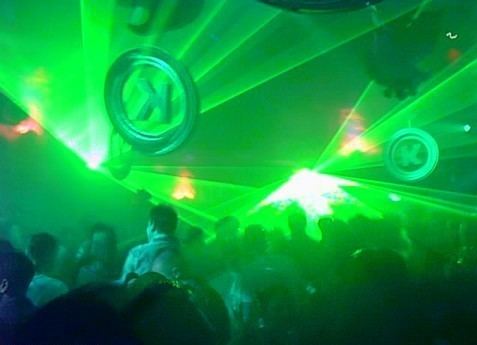 | ||
A Superclub is a term usually used to describe a very large or superior nightclub, often with several rooms with different themes the term was first coined in an article that appeared in the British electronic dance and clubbing magazine Mixmag in 1995
Contents
Definitions
Further definitions of a superclub may include a nightclub that has high capacity, is multi-story, high profile, and operates city and region wide or is well known by people. It can also be defined as a club that is owned and managed by a dance music record label or a club that was or is culturally important.The term may also be used to define it's position within the club scene hierarchy. or we can retrospectively apply the term to earlier nightclubs that fulfilled certain criteria in that they were also spatially large, had multiple rooms, levels, themes, large capacities and were deemed important during their respective time.
History
Notes:The list of clubs below indicate the dates they were first established.
1960s
The earliest examples of a where you could retrospectively apply the term 'superclub, were to Annabel's London opened in 1963 or Pacha, Sitges opened in (1967)
1970s
Early examples during this period where you could retrospectively apply the term 'superclub, include: Pacha, Ibiza in (1973) or Amnesia, Ibiza, (1976), Studio 54, New York City, (1977), Paradise Garage, New York, (1977), Ku Club Ibiza, (1978), Xenon, New York, (1978), Roxy NYC, New York, (1978), Heaven London, (1979), Danceteria, New York, (1979)
1980s
Examples of 'Superclubs' from this period included: The Saint in New York in (1980), The Fridge, London, (1981), The Haçienda in Manchester opened in (1982), The Limelight, New York, (1983), Hippodrome, London, (1983), Space, Ibiza, (1986), Tunnel, New York, (1986), Palladium, New York, (1985), Quadrant Park, Liverpool, (1988), Excalibur Nightclub, Chicago, (1989), The Sound Factory, New York, (1989).
1990s
Examples of 'Superclubs' from this period include: Trade and Turnmills, London, (1990), Ministry Of Sound in London (1991), Juliana's Tokyo, (1991), Zouk, Singapore, (1991), Avalon, Boston (1992), Bunker, Berlin, (1992), G-A-Y, London, (1993), Cream at Nation, Liverpool, (1993), Miss Moneypenny's, Birmingham, (1993), Twilo, New York, (1995), The End, London, (1995), Nation (Washington D.C., (1995), The Emporium. Coalville, (1995), Privilege, Ibiza, (1995), Gatecrasher One, (1996), The Church, Denver (1996), Godskitchen, (1996), King King, Los Angeles, (1998), Fabric, London (1999), DC10, Ibiza, (1999), Home, London, (1999)
2000s
Examples of 'Superclubs' from this period include: Womb, Tokyo, (2000), Bungalow 8, New York City, (2001), Vision Club, Chicago, (2002), Vanguard LA, Hollywood, (2002), SeOne, London, (2002), Berghain, Berlin, (2003), Cielo, New York, (2003), Opium Garden Miami, (2003), AIR, Birmingham, (2003), Crobar, Chelsea, New York, (2003), Pure, Las Vegas (2004), Sound Bar, Chicago, (2004), Myth, Minneapolis, (2005), TAO Las Vegas, (2005), 1015 Folsom Nightclub , San Francisco, (2005), Belo (San Diego), (2006), XS Nightclub, Las Vegas, (2008).
2010s
Examples of 'Superclubs' from this period include: White Dubai @ Meydan, (2013), Laroc, Sao Paulo, (2015),
Culturally important clubs
These clubs listed here do not necessarily meet the criteria for the spacial definition of a 'superclub' but are included for their significant cultural importance: Peppermint Lounge, (1958) and (1980), UFO Club, London (1960's), The Loft, New York City, (1970), The Warehouse, Chicago, (1977), Mudd Club, New York, (1978), Billy's London (1978), Blitz Club, London, (1979), Pyramid Club, New York, (1979), Club 57, New York, (1979), Camden Palace, London, (1982), The Batcave, London (1982), Taboo, London, (1985), The World, New York, (1986), Kinky Gerlinky, London, (1989), Vague Club. Leeds, (1993) B 018, Beirut, (1994).
Superclub the album
Cream, Gatecrasher and Pacha teamed up in 2010 to produce the album ‘Superclub’. Released on 22 November in the UK, the 3 CD collection features one disc for each of the clubs and was the first release from Rhino UK's dance imprint One More Tune. A second album, called 'Superclub Ibiza', was released in July 2011 by EMI.
